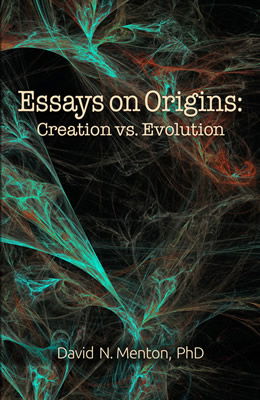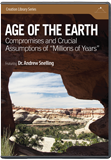
Creation and the Appearance of Age
Editor’s Note: First published in St. Louis MetroVoice 5, no. 8 (August 1995).
I am often asked if I really believe that God created everything in six, literal, 24-hour days—and I freely confess that I do find it difficult to believe such a thing. Why, I wonder, would God spend an entire six days doing a miracle that would require of Him literally no time at all? Think about it: How much time does a miracle take? How much time, for example, did Jesus take for His first miracle when He changed water into the finest quality wine (as judged by a professional steward) for the wedding at Cana? The answer, of course, is no time at all—He told the servants to fill the pots with water and serve it! Still, the Bible clearly reveals God took six whole days to initially create everything to perfection; so, we must either take God at His Word, or presume to stand in judgment of all Scripture.
Some Christians seem to have just the opposite problem with six-day creation—they find it difficult to believe that God could get the job done in only six ordinary days. They prefer to believe that the days of Creation were vastly longer than 24 hours—even over a billion years longer! (Perhaps they are confusing miracles with time-consuming work or luck.)
Still other Christians do not seem to doubt that God could have created everything in six ordinary days, yet insist that He didn’t because the universe just looks older than that. They point out that expert cosmologists have concluded that the universe gives every appearance of being at least 12 billion years old, and that the earth appears to be about 4.5 billion years old. Similarly, an expert viniculturist would have concluded that the superb wine Jesus provided for the wedding at Cana was at least a few years old and made from grapes, not mere water. In both cases, the experts might be right about the appearance of age, but wrong about the actual age of created things.1 Is God then trying to fool us, or perhaps testing our faith by making things appear older than they really are?
How, indeed, could God create anything that did not appear to us to be aged (like a fine wine) at the moment of its creation.
The appearance of age in the things that God created is a much-debated issue in contemporary Christian scientific circles. Can God—or more accurately—would God create something that at the very moment of its creation has the appearance of age? The short answer to this question may be: How else? How, indeed, could God create anything that did not appear to us to be aged (like a fine wine) at the moment of its creation.
Think of any one thing that our omnipotent God might instantly create out of nothing by the power of His Word. Let’s say you thought of a simple stone. If the stone is round, this would appear to show the effects of years of tumbling and wear. On the other hand, if it is sharply angular in shape it would appear to be a broken fragment of a larger, previously existing rock. Regardless of their shapes, rocks are hardened composites of previously existing materials such as molten magma and sedimentary silt. Even if you thought of silt itself, it must have come from the natural weathering and pulverization of previously existing rock. Or perhaps you thought of a simple hair—depending on its length, it might appear to be the product of several years of hair growth from a previously existing hair follicle. Maybe you thought of a visible star—depending on its distance from the earth, its light might appear to have been traveling for over a billion years to reach your eyes. All of these things would have the appearance of age and an ongoing process at the very moment of their creation.
Nowhere is the appearance of age and pre-existing process more interesting than in the sudden creation of the first human being. The Bible tells us that Adam was completely formed (presumably as an adult) before there was ever a woman on the earth. At the very moment of his creation, Adam would surely have appeared to us to be the product of a long growth and development process. Certainly in our experience today, a post-puberal human is a result of no less than 12–14 years of growth from the time of birth. The newborn baby, in turn, is typically the result of 8–9 months of development and maturation, starting with a fertilized egg in the womb of a previously existing mother. And of course, fertilization requires a father. The sperm cells of the father aren’t even produced until he reaches the age of puberty. Also let’s not forget the critically important placenta—its development in the womb necessarily precedes that of the baby so that it can serve the function of a temporary lung, kidney, liver, gut, and endocrine system until the baby develops its own. It’s no wonder that for centuries artists have been at a loss to portray just what the first couple’s abdominal region looked like—did they or did they not have a belly button? (You will note that artists generally avoided the whole issue by conveniently covering their midsections with nearby foliage.)
What came first, the chicken or the egg?
This whole line of thinking gets us into what is called a “first cause” problem. We live in a “cause and effect” world, where every action causes a reaction and is itself the result of a previous action. Everything appears to be an ongoing process for which we are incapable of really grasping a beginning. This is all popularly expressed in the age-old question: “What came first, the chicken or the egg?” If we say the chicken, we will be asked from whence the chicken came; yet if we say the egg, we will be asked from whence the egg—and so round and round we go. Somewhere, there had to be a beginning to this cyclical process we call the chicken and the egg. The Bible tells us that God created every bird out of nothing on the fifth day of the creation week, and that they have been reproducing after their kind ever since (Genesis 1:20–23).
Of course, none of this will satisfy the crass materialists who will demand to know where God came from and will scream foul if you tell them that God is eternal. Now if you ask the materialists how the chicken came to be, they will relate the following scenario: The chicken evolved by chance from other earlier and more primitive birds, which in turn evolved by chance from reptiles, which evolved from amphibians, which evolved from fish, which evolved from invertebrates, which evolved from single-cell organisms, which evolved from nonliving chemicals, which evolved from hydrogen gas, which evolved from the “Big Bang.” If you ask the materialists where the material of the Big Bang came from, they will either tell you it came into existence out of nothing, or it’s eternal!2
We may conclude that the Lord is captive to neither time nor process. The Psalmist says of God, “For a thousand years in Your sight are like yesterday when it is past” (Psalm 90:4). How much time after all does a yesterday take?
Essays on Origins: Creation vs. Evolution
Footnotes
- The question then is not really so much the appearance of age as it is the appearance of maturity. The wine was not old; it was mature.
- Editor’s Note: The original essay mentioned the “Cosmic Egg,” a theory most evolutionists no longer subscribe to.
Recommended Resources

Answers in Genesis is an apologetics ministry, dedicated to helping Christians defend their faith and proclaim the good news of Jesus Christ.
- Customer Service 800.778.3390
- © 2024 Answers in Genesis





